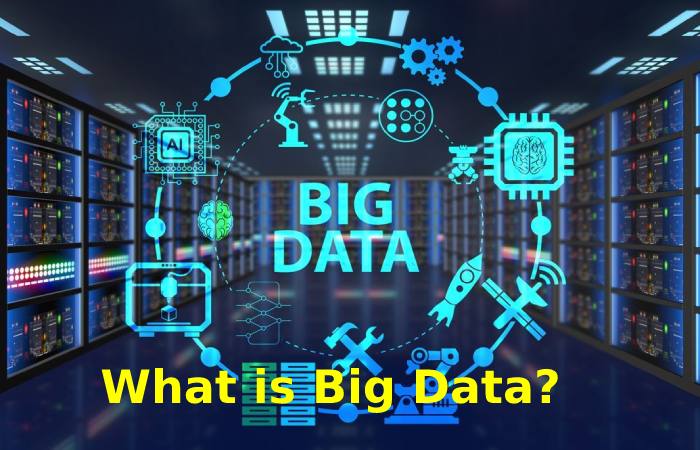Introduction
Big Data Technology is a combination of organized, semi-structured, and formless data collected from organizations that can be mined for insights and used in machine learning projects, predictive modeling, and other analytics application advancements.
The speed at which large amounts of data are generated, collected and processed. These characteristics were first recognized in 2001 by Doug Laney, then an analyst at consulting firm Meta Group Inc.; Gartner continued to popularize them after acquiring the Meta Group in 2005. More recently, other Vs. have been added to various descriptions of big data, including honesty, value, and variability.
Although Big Data does not represent a specific volume of data. Big Data implementations often span terabytes, petabytes, and even exabytes of data created and collected over time.
What is Big Data?

Big data refers to the large, diverse sets of information that increase. It encompasses the volume of information, the velocity or speed at which it is created and collected, and the variety or scope of the data points being covered (known as the “three v’s” of big data). Big data often comes from data mining and arrives in multiple formats.
- Big data is a vast amount of disparate information arriving in ever more significant amounts and ever faster.
- Big data can be structure (often digital, simply formatted and stored) or unstructured (freer, less quantifiable).
- Almost every department in an organization can use the results of big data analytics, but managing the clutter and noise can be challenging.
- Large amounts of data can be collected from publicly shared comments on social media and websites, voluntarily collected from personal electronic devices and applications, through questionnaires, product purchases, and electronic registration.
- Often large amounts of data are stored in computer databases and analyzed using software designed to handle large and complex amounts of data.
Why is big data important?
Corporations use Big Data technology in their systems to recover operations, provide better customer service, create personalized marketing campaigns, and take other actions to increase sales and profits. Therefore, companies that use it effectively have a potential competitive advantage over those that do not use it, as they can make quicker and more informed business decisions.
For example, big data provides valuable customer information that companies can use to refine their marketing, advertising, and promotions to increase customer engagement and conversion rates. In addition, real-time and historical data can be analyzed to assess the changing preferences of consumers or business buyers, allowing businesses to better respond to customer wants and needs.
Medical researchers also use big data technology to identify signs of disease and risk factors and doctors to diagnose diseases and conditions in patients. In addition, a mixture of data from electronic medical records, social networking sites. The Internet, and other sources provides healthcare organizations and government agencies with timely information about disease threats or outbreaks.
Also Read: Which Entrepreneur Would Likely Be Interested?
Here are some other examples of how organizations are using big data technology:
- In the energy sector, big data helps oil and gas companies identify potential drilling sites and monitor pipeline operations; similarly, utility companies use it to track power grids.
- Financial services companies use big data systems for risk management and real-time market data analysis.
- Manufacturers and transportation companies trust big data to manage their supply chains and enhance delivery routes.
- Other government applications include emergency response, crime prevention, and innovative city initiatives.
How does Big Data Technology work?
Before businesses can place big data to work for them, they should consider how it flows among many locations, sources, systems, owners, and users. Five critical steps remain to take charge of this “big data fabric” that includes traditional, structured data and unstructured and semi-structured data.
- Set a Big Data Strategy.
- Identify big data sources.
- Access, Accomplish, Store Big Data.
- Analyze the Big Data.
- Make Intelligent, Data-Driven Decisions.
1) Set a Big Data Strategy
Generally speaking, a big data strategy is a plan design to help you manage and improve how data is collect, store, manage, shared, and use within and outside your organization. A big data strategy creates the conditions for business success amid vast amounts of data. Therefore, when developing a plan, it is vital to consider existing and future business and technology goals and initiatives. This requires treating Big Data like any other valuable business asset and not just a by-product of applications.
2) Identify big data sources
Data transmission comes from the Internet of Things (IoT) and other connected devices. Flowing into the computing systems of wearable devices, smart cars, medical devices, industrial plants, and more. You can analyze this large amount of data as it comes in and decides which data to keep or not and which to investigate further.
Social media data comes from interactions on Facebook, YouTube, Instagram, etc. This includes large amounts of big data in images, video, voice, text, and sound, useful for marketing, sales, and support functions. This data is often unstructured or semi-structured and, as such, presents a unique challenge to mine and analyze.
Publicly available data comes from vast amounts of open data sources. Such as the US government’s data.gov, CIA World Facebook, or the European Union’s Open Data Portal. Other big data can come from data lakes, cloud data sources, vendors, and customers.
3) Access, Accomplish, and Store Big Data
Current computer systems provide the speed, power, and flexibility to access vast amounts and types of big data quickly. In addition to reliable access, organizations also need methods to integrate data, create data pipelines, ensure data quality, provide data management and storage, and prepare data for analysis. Some big data can also stored on-premises in a traditional data warehouse. Still, there are also flexible and cost-effective options for storing and managing big data through cloud solutions, data lakes, data pipelines, and Hadoop.
4) Analyze the Big Data
Organizations can use all their big data for analyses through high-performance tools like grid computing or in-memory analytics. Another method is to determine upfront which data is relevant before analyzing it. Big data analytics is how corporations gain value and insights from data. Big data feeds today’s innovative analytics endeavors such as artificial intellect (AI) and machine
5) Make Intelligent, Data-Driven Decisions
Well-managed trusted data indications to trusted analytics and delegated results. To stay competitive, businesses must seize the total value of big data and operate in a data-driven way – making decisions based on the evidence presented by big data rather than gut instinct. The benefits of being data-driven are clear. Data-driven establishments perform better, are operationally more predictable, and are more profitable.
The Uses of Big Data
Data analysts appearance at the relationship between different data types. Such as demographic data and purchase history, to determine whether a correlation exists. Such assessments may be done in-house or outside by a third party focusing on processing big data into digestible formats. In addition, businesses often evaluate big data by experts to turn it into actionable information.
Nearly each department in a company can use findings from data analysis. From human resources and technology to marketing and sales. As a result, big data aims to increase the speed at which products get to market. Reduce the time and resources required to gain market adoption and target audiences, and ensure customers remain satisfied.
Advantages and Disadvantages of Big Data Technology
They are increasing the amount of data available presents both opportunities and challenges. In general, having more data about customers (and potential customers) should allow companies to better tailor products and marketing efforts to achieve the highest levels of customer satisfaction and loyalty. In addition, organizations that collect large amounts of data have the opportunity to perform more profound and richer analyses for the benefit of all stakeholders.
While better analytics is good, big data can add overhead and noise, reducing its usefulness. Companies must manage large amounts of data and determine which data represents signal and noise. Deciding what makes the information relevant becomes a key factor.
In addition, the nature and format of the data may require special treatment before being process. For example, structured data consisting of numerical values can be easily store and classified. On the other hand, unstructured data, such as emails, videos. And text documents, may require the application of more sophisticated techniques before they are helpful.
Conclusion
As more and more data is produce, collected, data analysis requires scalable, flexible, and powerful tools to deliver timely insights. However, organizations face a growing big data ecosystem where new devices quickly emerge and become obsolete.
Also Read: What is the MWM? Mobile Workforce Management
Related posts
Featured Posts
StopWatt Reviews – The Most Effective Method to Save Energy
Are you ready to step into a brighter future of energy efficiency? Say hello to Stop Watt, the revolutionary energy…
Tips to Survive Crypto Bear Market
Introduction crypto bear market: Crypto investors and traders have started on the right foot. Even going out of their way…


